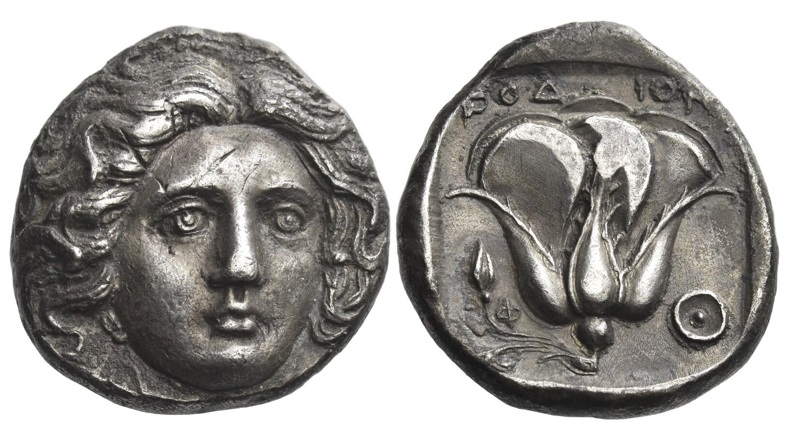400 BCE - 385 BCE | POΔ – ION
Overstriking coin
Rhodes_Numismatica_Ars_Classica,_134,_21_Nov._2022,_242+.jpg
[1]
|
|
Sale(s)Sale(s) ᵖ:
|
Hess-Leu, 24 March 1959, 263 = Numismatica Ars Classica, 134, 21 Nov. 2022, 242
|
| Private collection(s)Private collection(s) ᵖ:
|
From a Distinguished Swiss collection.
|
|
Description
| ObverseInscription or printing placed on the obverse.:
|
Facing head of Helios, slightly r.
|
ReverseInscription or printing placed on the reverse.:
|
POΔ – ION (Greek) Rose with bud l., in field, Φ and phiale. All within incuse square
|
Mint and issuing power
| MintIdentifies the place of manufacture or issue of a numismatic object.:
|
Rhodes
|
Ancient regionAncient region.
|
Caria (islands)
|
Modern countryModern country: Greece
|
AuthorityIdentifies the issuing power. The authority can be "pretended" when the name or the portrait of X is on the coin but he/she was not the issuing power. It can also be "uncertain" when there is no mention of X on the coin but he/she was the issuing power according to the historical sources:
|
|
Chronology
| FromIdentifies the initial date in a range assigned in a numismatic context. 400 BCE toIdentifies the final date in a range assigned in a numismatic context.. 385 BCE
|
Classical 480-323 BC  periodTime period of the numismatic object. periodTime period of the numismatic object.
|
Physical description
MetalThe physical material (usually metal) from which an object is made.: Silver 
|
WeightWeight of the numismatic object (in grams). in grams: 15.0915.09 g <br />15,090 mg <br />
|
DenominationTerm indicating the value of a numismatic object. Examples: tetradrachm, chalkous, denarius.: tetradrachm 
|
|
|
|
|
References
Description
| ObverseInscription or printing placed on the obverse.:
|
|
ReverseInscription or printing placed on the reverse.:
|
|
Mint and issuing power
| MintIdentifies the place of manufacture or issue of a numismatic object. ᵖ:
|
|
Ancient regionAncient region. ᵖ
|
|
Modern countryModern country:
|
AuthorityIdentifies the authority in whose name (explicitly or implicitly) a numismatic object was issued. ᵖ:
|
|
Chronology
| FromIdentifies the initial date in a range assigned in a numismatic context. toIdentifies the final date in a range assigned in a numismatic context..
|
periodTime period of the numismatic object.
|
Physical description
References
References
- ^ Sear, David R. (1979), Greek coins and their values. Vol. II, Asia and North Africa, London, xlviii, p. 317-762
- ^ Callataÿ, François de (2003), Recueil quantitatif des émissions monétaires archaïques et classiques, Numismatique Romaine, Wetteren, VII + 267 p.
- ^ Ashton, Richard (2001), "The coinage of Rhodes 408-c.190 BC", in Andrew Meadows and Kirsty Shipton (eds.), Money and its uses in the ancient world, Oxford, Oxford University Press, p. 79-115.
- ^ Hoover, Oliver D. (2010), The Handbook of Greek Coinage Series, volume 6 : handbook of coins of the islands: Adriatic, Iionian, Thracian, Aegean, and Carpathian seas (excluding Crete and Cyprus), sixth to first centuries BC, Lancaster, 358 p.

